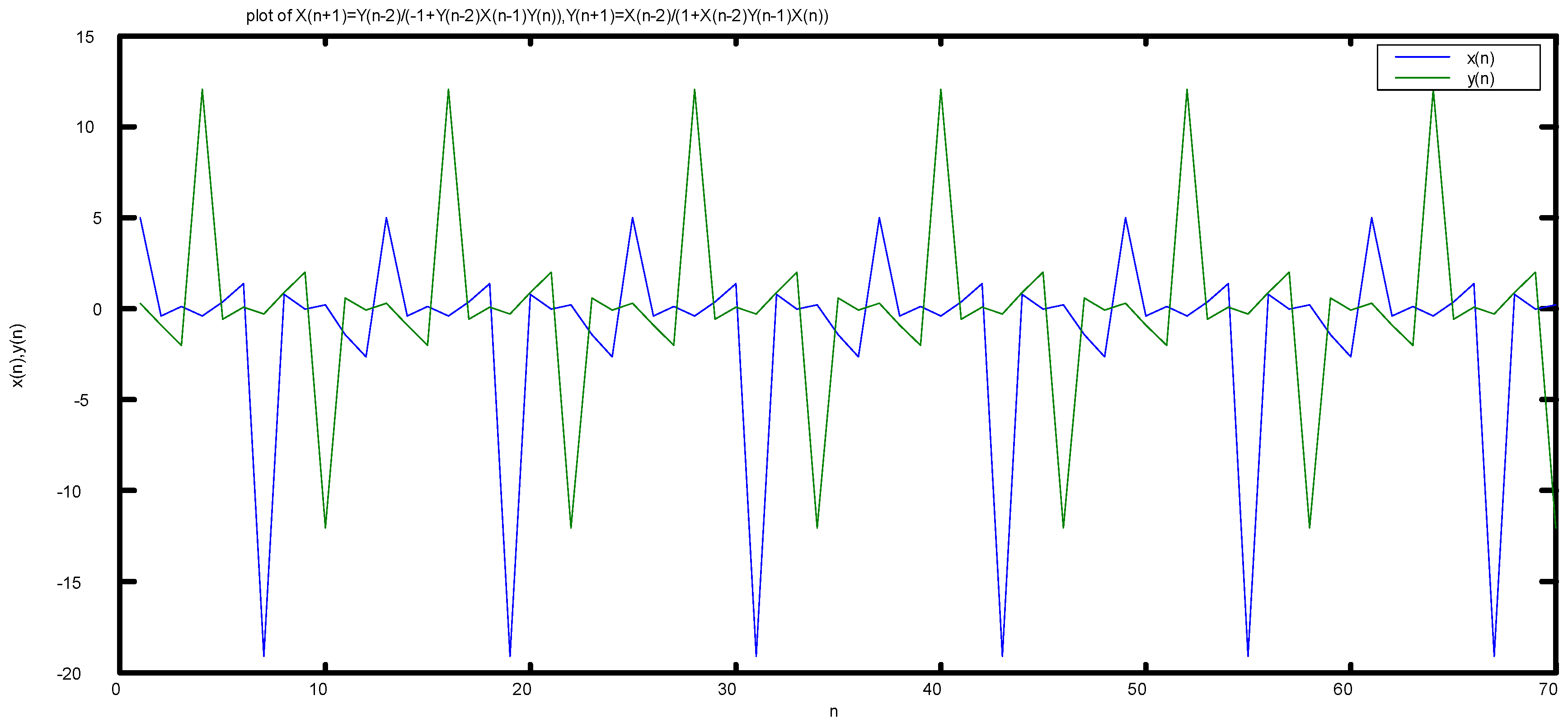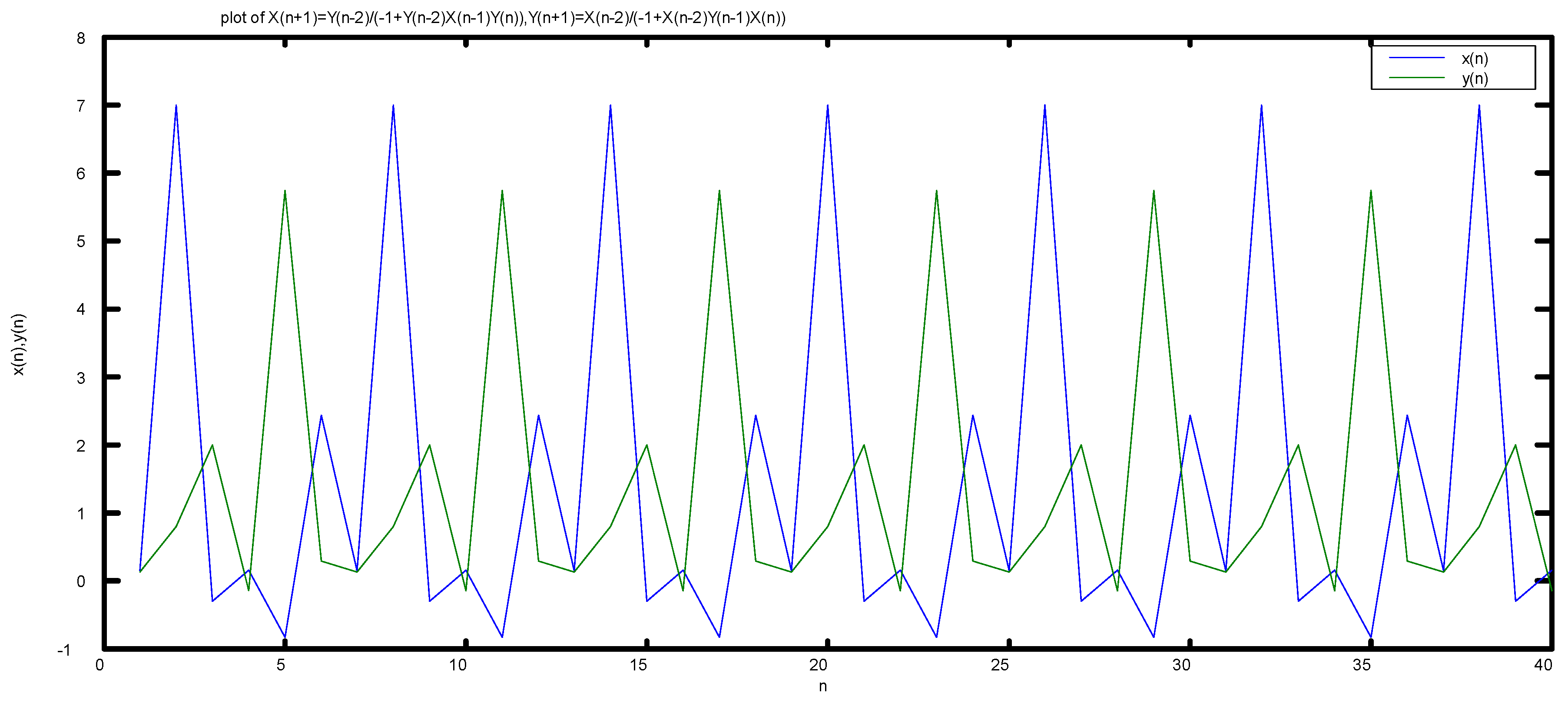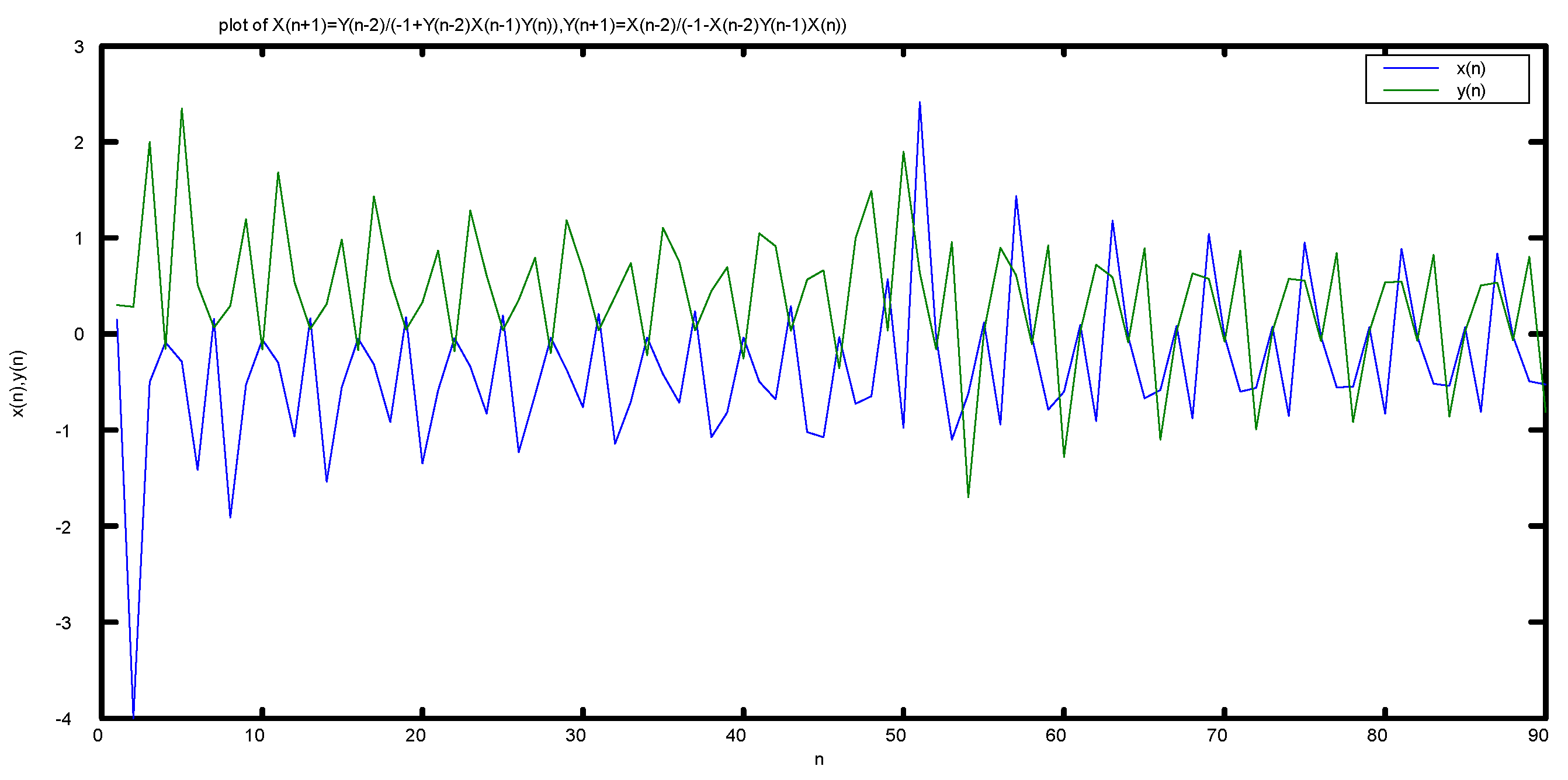Solution for Rational Systems of Difference Equations of Order Three
Abstract
:1. Introduction
2. The System:
3. The System:
4. The System:
5. The System:
- (i)
- If then we have and
- (ii)
- If then we have and
- (iii)
- If then we have and
- (iv)
- If then we have and
- (v)
- If then we have and
- (vi)
- If then we have and
Conflicts of Interest
References
- Camouzis, E.; Papaschinopoulos, G. Global asymptotic behavior of positive solutions on the system of rational difference equations xn+1 = 1 + 1/yn−k, yn+1 = yn/xn−myn−m−k. Appl. Math. Lett. 2004, 17, 733–737. [Google Scholar] [CrossRef]
- Cinar, C. On the positive solutions of the difference equation system xn+1 = 1/yn, yn+1 = yn/xn−1yn−1. Appl. Math. Comput. 2004, 158, 303–305. [Google Scholar] [CrossRef]
- Elabbasy, E.M.; El-Metwally, H.; Elsayed, E.M. On the Solutions of a Class of Difference Equations Systems. Demonstr. Math. 2008, 41, 109–122. [Google Scholar]
- Elsayed, E.M. On the solutions of a rational system of difference equations. Fasc. Math. 2010, 45, 25–36. [Google Scholar]
- Grove, E.A.; Ladas, G.; McGrath, L.C.; Teixeira, C.T. Existence and behavior of solutions of a rational system. Commun. Appl. Nonlinear Anal. 2001, 8, 1–25. [Google Scholar]
- Kurbanli, A.S.; Cinar, C.; Yalçinkaya, I. On the behavior of positive solutions of the system of rational difference equations xn+1 = xn−1/ynxn−1 + 1, yn+1 = yn−1/xnyn−1 + 1. Math. Comput. Model. 2011, 53, 1261–1267. [Google Scholar] [CrossRef]
- Kurbanli, A.S. On the behavior of solutions of the system of rational difference equations xn+1 = xn−1/ynxn−1 − 1, yn+1 = yn−1/xnyn−1 − 1, zn+1 = 1/ynzn. Adv. Differ. Equ. 2011, 2011, 40. [Google Scholar] [CrossRef]
- Ozban, A.Y. On the system of rational difference equations xn+1 = a/yn−3, yn+1 = byn−3/xn−qyn−q. Appl. Math. Comput. 2007, 188, 833–837. [Google Scholar] [CrossRef]
- Papaschinopoulos, G.; Schinas, C.J. On a system of two nonlinear difference equations. J. Math. Anal. Appl. 1998, 219, 415–426. [Google Scholar] [CrossRef]
- Schinas, C.J. Invariants for difference equations and systems of difference equations of rational form. J. Math. Anal. Appl. 1997, 216, 164–179. [Google Scholar] [CrossRef]
- El-Dessoky, M.M.; Elsayed, E.M.; Alghamdi, M. Solutions and periodicity for some systems of fourth order rational difference equations. J. Comput. Anal. Appl. 2015, 18, 179–194. [Google Scholar]
- Touafek, N.; Elsayed, E.M. On the solutions of systems of rational difference equations. Math. Comput. Model. 2012, 55, 1987–1997. [Google Scholar] [CrossRef]
- Zhang, Y.; Yang, X.; Megson, G.M.; Evans, D.J. On the system of rational difference equations. Appl. Math. Comput. 2006, 176, 403–408. [Google Scholar] [CrossRef]
- Zhang, Y.; Yang, X.; Evans, D.J.; Zhu, C. On the nonlinear difference equation system. Comput. Math. Appl. 2007, 53, 1561–1566. [Google Scholar] [CrossRef]
- El-Dessoky, M.M. On the solutions and periodicity of some nonlinear systems of difference equations. J. Nonlinear Sci. Appl. 2016, 9, 2190–2207. [Google Scholar]
- Alzahrani, E.O.; El-Dessoky, M.M.; Elsayed, E.M.; Kuang, Y. Solutions and Properties of Some Degenerate Systems of Difference Equations. J. Comput. Anal. Appl. 2015, 18, 321–333. [Google Scholar]
- Agarwal, R.P. Difference Equations and Inequalities, 1st ed.; Marcel Dekker: New York, NY, USA, 1992. [Google Scholar]
- Battaloglu, N.; Cinar, C.; Yalçinkaya, I. The dynamics of the difference equation. Ars Comb. 2010, 97, 281–288. [Google Scholar]
- Clark, D.; Kulenovic, M.R.S. A coupled system of rational difference equations. Comput. Math. Appl. 2002, 43, 849–867. [Google Scholar] [CrossRef]
- Özban, A.Y. On the positive solutions of the system of rational difference equations xn+1 = 1/yn−k, yn+1 = yn/xn−myn−m−k. J. Math. Anal. Appl. 2006, 323, 26–32. [Google Scholar] [CrossRef]
- El-Dessoky, M.M.; Mansour, M.; Elsayed, E.M. Solutions of some rational systems of difference equations. Util. Math. 2013, 92, 329–336. [Google Scholar]
- Qureshi, M.N.; Khan, A.Q.; Din, Q. Global behavior of third order system of rational difference equations. Int. J. Eng. Res. Technol. 2013, 2, 2182–2191. [Google Scholar]
- Denette, E.; Kulenović, M.R.S.; Pilav, E. Birkhoff Normal Forms, KAM Theory and Time Reversal Symmetry for Certain Rational Map. Mathematics 2016, 4, 20. [Google Scholar] [CrossRef]
- Hu, L.-X.; Jia, X.-M. Global Asymptotic Stability of a Rational System. Abstr. Appl. Anal. 2014, 2014, 286375. [Google Scholar] [CrossRef] [PubMed]
- El-Dessoky, M.M.; Elsayed, E.M. On the solutions and periodic nature of some systems of difference equations. J. Comput. Anal. Appl. 2015, 18, 206–218. [Google Scholar]
- Yalçinkaya, I.; Cinar, C.; Simsek, D. Global asymptotic stability of a system of difference equations. Appl. Anal. 2008, 87, 689–699. [Google Scholar] [CrossRef]
- El-Dessoky, M.M. On a solvable for some systems of rational difference equations. J. Nonlinear Sci. Appl. 2016, 9, 3744–3759. [Google Scholar]
- Yalçinkaya, I.; Cinar, C.; Atalay, M. On the solutions of systems of difference equations. Adv. Differ. Equ. 2008, 2008, 143943. [Google Scholar] [CrossRef]
- Yang, X.; Liu, Y.; Bai, S. On the system of high order rational difference equations xn = a/yn−p, yn = byn−p/xn−qyn−q. Appl. Math. Comput. 2005, 171, 853–856. [Google Scholar] [CrossRef]
- Erdoğan, M.E.; Cinar, C.; Yalçınkaya, I. On the dynamics of the recursive sequence. Comput. Math. Appl. 2011, 61, 533–537. [Google Scholar] [CrossRef]
- Elsayed, E.M.; El-Dessoky, M.M.; Alotaibi, A. On the Solutions of a General System of Difference Equations. Discret. Dyn. Nat. Soc. 2012, 2012, 892571. [Google Scholar] [CrossRef]
- El-Dessoky, M.M. The form of solutions and periodicity for some systems of third—Order rational difference equations. Math. Methods Appl. Sci. 2016, 39, 1076–1092. [Google Scholar] [CrossRef]
- El-Dessoky, M.M.; Elsayed, E.M. On a solution of system of three fractional difference equations. J. Comput. Anal. Appl. 2015, 19, 760–769. [Google Scholar]
- Yalçinkaya, I. On the global asymptotic behavior of a system of two nonlinear difference equations. Ars Comb. 2010, 95, 151–159. [Google Scholar]
- Yalçinkaya, I. On the global asymptotic stability of a second-order system of difference equations. Discret. Dyn. Nat. Soc. 2008, 2008, 860152. [Google Scholar] [CrossRef]
- El-Dessoky, M.M. On a systems of rational difference equations of Order Two. Proc. Jangjeon Math. Soc. 2016, 19, 271–284. [Google Scholar]
- Elsayed, E.M.; Mansour, M.; El-Dessoky, M.M. Solutions of fractional systems of difference equations. Ars Comb. 2013, 110, 469–479. [Google Scholar]
- Mansour, M.; El-Dessoky, M.M.; Elsayed, E.M. On the solution of rational systems of difference equations. J. Comput. Anal. Appl. 2013, 15, 967–976. [Google Scholar]
- Bisci, G.M.; Repovs, D. On sequences of solutions for discrete anisotropic equations. Expos. Math. 2014, 32, 284–295. [Google Scholar] [CrossRef]
- Bisci, G.M.; Repovs, D. Nonlinear Algebraic Systems with discontinuous terms. J. Math. Anal. Appl. 2013, 398, 846–856. [Google Scholar] [CrossRef]
- Galewski, M.; Bisci, G.M.; Wieteska, R. Existence and multiplicity of solutions to discrete inclusions with the p(k)-Laplacian problem. J. Differ. Equ. Appl. 2015, 21, 887–903. [Google Scholar] [CrossRef]
- Bisci, G.M.; Repovs, D. Existence of solutions for p-Laplacian discrete equations. Appl. Math. Comput. 2014, 242, 454–461. [Google Scholar] [CrossRef]
- Candito, P.; Bisci, G.M. Existence of positive solutions for nonlinear algebraic systems with a parameter. Appl. Math. Comput. 2012, 218, 11700–11707. [Google Scholar] [CrossRef]




© 2016 by the author; licensee MDPI, Basel, Switzerland. This article is an open access article distributed under the terms and conditions of the Creative Commons Attribution (CC-BY) license (http://creativecommons.org/licenses/by/4.0/).
Share and Cite
El-Dessoky, M.M. Solution for Rational Systems of Difference Equations of Order Three. Mathematics 2016, 4, 53. https://doi.org/10.3390/math4030053
El-Dessoky MM. Solution for Rational Systems of Difference Equations of Order Three. Mathematics. 2016; 4(3):53. https://doi.org/10.3390/math4030053
Chicago/Turabian StyleEl-Dessoky, Mohamed M. 2016. "Solution for Rational Systems of Difference Equations of Order Three" Mathematics 4, no. 3: 53. https://doi.org/10.3390/math4030053




